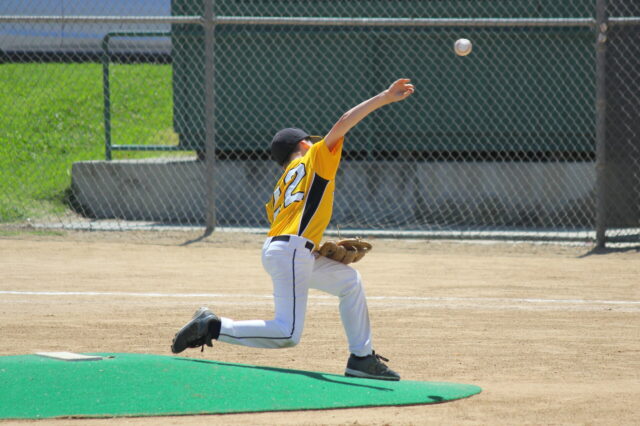UF Health survey shows caregivers of youth baseball pitchers unaware of overuse guidelines

The human arm just isn’t designed to throw a baseball, whether it belongs to a major leaguer torching a batter with a 100 mph fastball or a 10-year-old whose toss wouldn’t break a pane of glass.
“If you look at the ligament in the elbow, the ulnar collateral ligament, it isn’t by itself meant to resist the stress that it sees from throwing a baseball,” said Kevin Farmer, M.D., a University of Florida Health orthopaedic surgeon specializing in sports medicine.
Even so, UCLs survive through good pitching mechanics that disperse the force of a throw, in addition to the enforcement of rest periods and pitch counts that help pitchers avoid overuse arm injuries.
But a University of Florida Health survey of parents and caregivers of youth baseball pitchers in North Central Florida found that 83% of the nearly 100 quizzed were unaware of the existence of safe pitching guidelines. It is a disquieting trend researchers believe points to a wider problem beyond the region. This lack of knowledge was true regardless of a player’s experience level.
The findings were published last month in the International Journal of Sports Physical Therapy.
With players under age 18 pitching more and more frequently, often for several teams in different leagues year-round, surgeons like Farmer are seeing a veritable plague of injuries. Sometimes young players even require Tommy John surgery to repair torn UCLs, an operation most people associate with major leaguers rather than adolescents.
“It’s really important that somebody is watching the players closely to make sure they aren’t pitching too much so we can minimize the risk of injury,” said Farmer, an associate professor in the UF College of Medicine’s department of orthopaedics and senior author of the journal article.
American youth baseball boasts an estimated 200,000 teams, so it’s imperative to educate parents and caregivers to track their children’s pitching burden, said Farmer, who also serves a UF team physician.
Even among the minority of caregivers who are aware of safe pitching guidelines, many were unsure of what exactly those guidelines were, said Christian Reintgen, M.D., a fifth-year orthopaedics resident who is lead author of the paper.
The guidelines are available online, including on websites for the Little League, USA Baseball and even Major League Baseball. The MLB site includes guidelines for pulling a pitcher after specific pitch counts and recommends rest durations for players ages 7 to 22 years.
“Safe pitching guidelines are in place to, first and foremost, protect your child and to protect the youth baseball players of America,” Reintgen said. “With a big game coming up, a pitcher wants to play. But it is important to remember health has to come first and no one is going to do well if they suffer from repetitive overuse injuries. They could end up in surgery.”
And in the end, he noted, injury could permanently sideline a player from a sport they love.
The survey also found those who played baseball more than six months a year were significantly more prone to experience throwing arm pain after performance. Just more than half of the caregivers polled recalled their child having throwing arm pain as a direct result of pitching, with half of those missing a game or pitching appearance.
The survey also found that 27% of caregivers’ children went on to seek medical evaluation for arm discomfort.
It has become ever more difficult for youth coaches to properly track pitcher usage because pitchers increasingly play on multiple teams throughout the year, especially in warmer climates such as Florida’s.
Indeed, the survey shows that 44% of players participated in more than one league while 18% pitched nine months or more each year. Findings published in 2018 by Jason Zaremski, M.D., co-medical director for the High School Outreach Program, Deparmtent of Physical Medicine and Rehabilitation and Department of Orthoaepdics at UF Health, showed that many pitches thrown by high school players, such as during warmups or in the bullpen, went uncounted and added significantly to pitchers’ injury risk.
That makes it incumbent on parents to keep track themselves, Farmer said.
“We’ve shown time and time again that kids who play more and throw more are at higher risk of injury,” Farmer said. “I think coaches, for the most part, understand the importance of tracking pitch counts. There is often just no way for them to know how much someone is pitching elsewhere, out of their sight. We all need to do a better job as specialists to get the word out there.”
Farmer, a former college baseball player who participated in youth leagues as a youngster, knows just how hard it is to convince young players to take time off.
Farmer, however, wasn’t a pitcher. He was a position player who swung for the fences.
“Fortunately,” he said, “I wasn’t good enough to pitch that often.”
Media contact: Ken Garcia at kdgarcia@ufl.edu or 352-265-9408.
About the author
